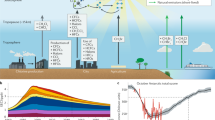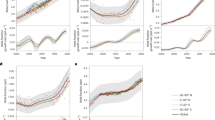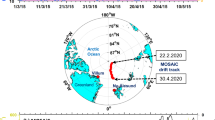Abstract
CHLORINE and bromine have been implicated in the massive springtime depletion of stratospheric ozone over Antarctica1. As the source of these halogens is anthropogenic emissions of halo-alkanes, the problem has acquired political and economic significance2. The chemical industry has been forced to consider urgently possible replacements for conventional halocarbons, and the potential effects on the environment of proposed alternative compounds have been evaluated recently in the Alternative Fluorocarbon Environmental Acceptability Study (AFEAS)3. Three such compounds that are not included in the AFEAS report are CF2BrH (halon 1201). CF3CFBrH (halon 2401) and CF3CF2CC12H (HCFC 225ca). Removal of these compounds from the atmosphere will occur primarily by reaction with the hydroxyl radical, OH (ref. 4). Here we determine, from laboratory studies, the absolute rate of reaction between these three species and OH. Such kinetic data are vital for assessing their viability as replacement compounds. We use these data, along with our measurements of ultraviolet absorption cross-sections, to estimate the tropospheric lifetimes of the halons and HCFC 225ca against removal by OH, and their potential for destroying ozone in the stratosphere. Our approach shows how laboratory measurements can provide a useful first estimate of the environmental acceptability of compounds of this sort.
This is a preview of subscription content, access via your institution
Access options
Subscribe to this journal
Receive 51 print issues and online access
$199.00 per year
only $3.90 per issue
Buy this article
- Purchase on Springer Link
- Instant access to full article PDF
Prices may be subject to local taxes which are calculated during checkout
Similar content being viewed by others
References
Anderson, J. G. et al. J. geophys. Res. 34, 11480–11520 (1989).
Montreal Protocol on substances that deplete the Ozone Layer, Final Act (United Nations Environment Program, Nairobi, 1987).
World Meteorological Organisation Global Ozone Research and Monitoring Project, Rep. No. 20, Scientific Assessment of Stratospheric Ozone 1989 Vol. 2 Appendix: AFEAS Rep. (WMO, Geneva, 1990).
Derwent, R. G., Volz-Thomas, A. & Prather, M. J. Global Ozone Research and Monitoring Project. Rep. No. 20, Scientific Assessment of Stratospheric Ozone: 1989 Vol. 2, Appendix: AFEAS Rep., 123 (WMO, Geneva, 1990).
Boodaghians, R. B., Canosa-Mas, C. E., Carpenter, P. & Wayne, R. P. JCS Faraday Trans. 2 84, 931–948 (1988).
Burrows, J. P., Wallington, T. J. & Wayne, R. P. JCS Faraday Trans. 2 79, 111–122 (1983).
Burrows, J. P., Wallington, T. J. & Wayne, R. P. JCS Faraday Trans. 2 80, 957–971 (1984).
Atkinson, R. Chem. Rev. 86, 69–201 (1986).
Prather, M. J. Global Ozone Research and Monitoring Project, Rep. No. 20, Scientific Assessment of Stratospheric Ozone: 1989 Vol. 2, Appendix: AFEAS Rep., 147–158 (WMO, Geneva, 1990).
Midgley, P. M. Atmos. Envir. 23, 2663–2665 (1989).
Wine, P. H. & Chameides, W. L. Global Ozone Research and Monitoring Project, Rep. No. 20, Scientific Assessment of Stratospheric Ozone: 1989 Vol. 2, Appendix: AFEAS Rep., 267–295 (WMO, Geneva, 1990).
Prinn, R. et al. Science 238, 945–950 (1987).
Fisher, D. A. et al. Global Ozone Research and Monitoring Project, Rep. No. 20, Scientific Assessment of Stratospheric Ozone: 1989 Vol. 2, Appendix: AFEAS Rep., 299–377 (WMO, Geneva, 1990).
World Meteorological Organisation Global Ozone Research and Monitoring Project, Rep. No. 20, Scientific Assessment of Stratospheric Ozone: 1989 Vol. 2, Appendix: AFEAS Rep., Ch. 6 (WMO, Geneva, 1990).
Gillotay, D., Simon, P. C. & Brasseur, G. Planet. Space Sci. 37, 105–108 (1989).
Hubrich, C. & Stuhl, F. J. Photochem. 12, 93–107 (1980).
World Meteorological Organisation Global Ozone Research and Monitoring Project, Rep. No. 20, Scientific Assessment of Stratospheric Ozone: 1989 Vol. 1, 402–410 (WMO, Geneva, 1990).
Molina, L. T., Molina, M. J. & Rowland, F. S. J. phys. Chem. 86, 2672–2676 (1982).
Author information
Authors and Affiliations
Rights and permissions
About this article
Cite this article
Brown, A., Canosa-Mas, C., Parr, A. et al. Tropospheric lifetimes of three compounds for possible replacement of CFC and halons. Nature 347, 541–543 (1990). https://doi.org/10.1038/347541a0
Received:
Accepted:
Published:
Issue Date:
DOI: https://doi.org/10.1038/347541a0
This article is cited by
-
New soluble anthracene-based polymer for opto-electronic applications
Journal of Materials Science (2016)
-
Ultraviolet absorption spectra of some Br-containing haloalkanes
Journal of Atmospheric Chemistry (1995)
-
Rate constants for reactions of OH radicals with some Br-containing haloalkanes
Journal of Atmospheric Chemistry (1993)
Comments
By submitting a comment you agree to abide by our Terms and Community Guidelines. If you find something abusive or that does not comply with our terms or guidelines please flag it as inappropriate.



